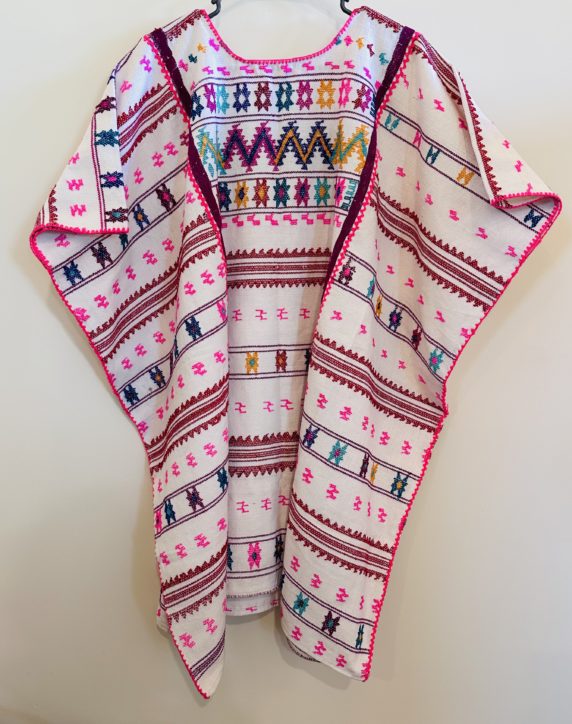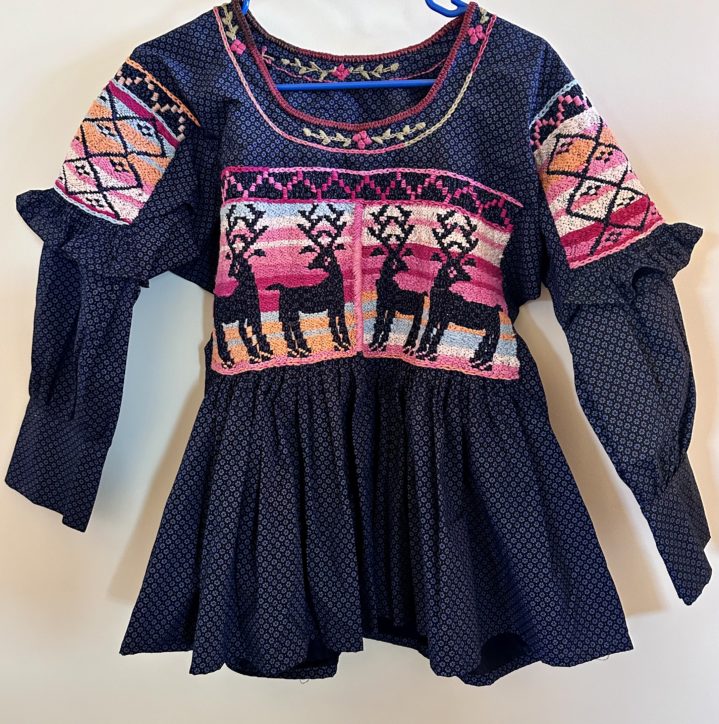Indigo blue is one of those magical colors that so many of us covet. It comes from a leafy green plant that looks like pea shoots and is found in many countries around the equator including Africa, India, Japan AND Oaxaca, Mexico. Laboriously cultivated and processed in the humid conditions of Santiago Niltepec near the Isthmus of Tehuantepec, Mexican indigo yields a deep, rich blue color when it is dipped in the fermented dye bath several times.
In fact, indigo is not technically a dye but a pigment, which coats but doesn’t penetrate the fibers. It can be used successfully on animal and plant fibers like wool, cotton, linen and silk it can also be used to color wood and concrete. It does not need a mordant, but it is tricky to work with! Our dye workshop shows you how.

We call it magic because it is precise chemistry, where oxidization occurs to release the color. When you dip the fiber into the dye bath then lift it out, you watch the material change magically from green to blue before your eyes. The amount of indigo, water temperature, and fructose added to the dye bath (an organic, non-toxic natural sugar) must be precise.

Indigo was used to distinguish royalty in many cultures around the world and the French used it to distinguish the color of their military garb.
One-Day Indigo Dye Workshop
From 10:00 am to 3:00 pm. You grind the indigo into powder and prepare the dye bath, learning at least two different recipes and the history of indigo in Oaxaca. You will experiment with a shibori technique and solid color dyeing on cotton. If you wish, you can bring a small amount of linen or silk to experiment with, too. You will have a choice of making napkins, a table runner or a scarf.
You set your own dates. Please send several dates you are available and we will advise as to our availability.
Private workshop fee is $235 for one person. $195 per person for two or more people.

How to Register and Pay: Send Norma Schafer an email to tell us your preferred dates. We will check available dates and let you know. Then, you tell us you are ready to register.
You can choose one of three ways to reserve with a non-refundable 25% deposit:
- Zelle bank transfer with no service fee
- PayPal with a 3% service fee (we send you a request for funds)
- Venmo with a 3% service fee (we send you a request for funds)
Please tell us which payment method you prefer when you tell us you want to register.

The balance is due in cash on the day of the workshop in either US dollars or MXN pesos (at the exchange rate of the day).
Once you register and make your deposit, we send you a confirmation along with the location of the dye studio, which is located in the historic district of Oaxaca city, about a 20 minute walk from the Zocalo.
- Lunch is on your own. You can bring a lunch or go out in the neighborhood.
- Please bring your own drinks and snacks.
- We give directions to the workshop after you register and pay the registration fees.
- Please, no children under the age of 15.
About Your Instructor: The workshop instructors are knowledgeable experts in the natural dye process and materials. They provide dyed wool and cotton yarns and thread for many of Oaxaca’s famous weavers and textile designers, and work with textile designers worldwide to offer customized colors that are used in fashion and home goods.
Please let us know if you have any questions. Thank you.































Women Weavers in Teotitlan del Valle, Oaxaca: Part One
Recently, I spent the day with a University of Michigan, public policy and economic development researcher, who asked me to introduce her to the Zapotec weaving culture of Teotitlan del Valle. Her expertise is India. Now, she is exploring how India and Mexico intersect and diverge in their support of artisans, particularly weavers.
hand-woven indigo rug with dye prepared by Juana Gutierrez
During our almost 10-hour day, we visited with five weaving families who work in natural dyes, two of whom are official cooperatives, registered with the government. One of these cooperatives, Vida Nueva (New Life), is solely woman-operated. Our time with spokeswoman Pastora Gutierrez enlightened my knowledge about how women came to become weavers in Teotitlan del Valle.
Federico Chavez Sosa at his loom in Teotitlan del Valle
Weaving on the fixed-frame pedal loom is mostly men’s work. The looms are big and heavy. It takes upper body strength to operate them. When the Spanish friars introduced this tapestry loom (along with churro sheep) to New Spain with the conquest, they trained men to use it, just as men traditionally worked this loom in Europe to create textiles for warmth.
Oaxaca tapestry looms turned out blankets, ponchos, sarapes and other articles of functional cloth for insulation used by people and horses.
Started in the early 1940’s, during World War II when men were overseas, the United States Bracero program opened the opportunity for Mexican men to work legally as temporary, seasonal agricultural laborers. From 1948 to 1964, more than 200,000 Mexican worked in U.S. agriculture each year.
Hand-woven tapestries with spinning wheel
Talk to anyone in Teotitlan del Valle and you will meet someone who participated in this program or has a relative who did. I am told the impact on Teotitlan del Valle was huge and saw the exodus of many of its young and middle-age men. They worked in the fields and orchards of America to earn a living to support their families.
Many men didn’t return.
This is when most women learned to weave.
Young women, who always did the cleaning, carding and spinning of sheep wool, learned to dress the loom and weave tapestries. Many began producing sellable textiles by age 11. Mothers, aunts, sisters, nieces and cousins came together to make this a family endeavor until the men returned, much like the sewing bee in small town USA. The making and selling of textiles remained closely within the family group.
Old sarape design, now a floor rug
By the mid-1970’s, Teotitlan del Valle weaving shifted from blankets and clothing to ornamental floor rugs, brought on by the market demand of Santa Fe interior design style. Importers developed relationships with village weavers who became exporters. Many were men who had learned a little English working in the Bracero program and had returned to the family and village infrastructure.
Resources
Book: Zapotec Women by Lynn Stephen, Duke University Press
Like this:
6 Comments
Posted in Cultural Commentary, Mexican Immigration, Teotitlan del Valle, Textiles, Tapestries & Weaving
Tagged bracero, culture, dye, farmworker, history, Mexico, natural, Oaxaca, tapestry, textiles, weaver, weaving, Women